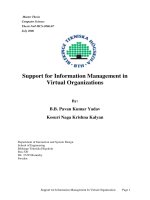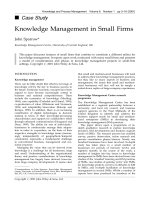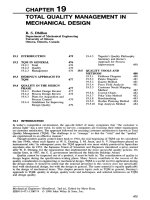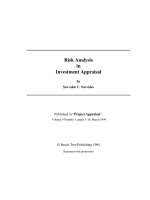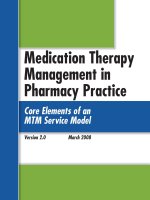Risk Management in Credit Portfolios doc
Bạn đang xem bản rút gọn của tài liệu. Xem và tải ngay bản đầy đủ của tài liệu tại đây (3.04 MB, 267 trang )
Contributions to Economics
For further volumes:
/>Martin Hibbeln
Risk Management in Credit
Portfolios
Concentration Risk and Basel II
Dr. Martin Hibbeln
Technische Universita
¨
t Braunschweig
Institute of Finance
Carl-Friedrich-Gauß-Faculty
Abt-Jerusalem-Str. 7
38106 Braunschweig
Germany
ISSN 1431-1933
ISBN 978-3-7908-2606-7 e-ISBN 978-3-7908-2607-4
DOI 10.1007/978-3-7908-2607-4
Springer Heidelberg Dordrecht London New York
Library of Congress Control Number: 2010934306
# Springer-Verlag Berlin Heidelberg 2010
This work is subject to copyright. All rights are reserved, whether the whole or part of the material is
concerned, specifically the rights of translation, reprinting, reuse of illustrations, recitation, broadcasting,
reproduction on microfilm or in any other way, and storage in data banks. Duplication of this publication
or parts thereof is permitted only under the provisions of the German Copyright Law of September 9,
1965, in its current version, and permission for use must always be obtained from Springer. Violations
are liable to prosecution under the German Copyright Law.
The use of general descriptive names, registered names, trademarks, etc. in this publication does not
imply, even in the absence of a specific statement, that such names are exempt from the relevant protective
laws and regulations and therefore free for general use.
Cover design: SPi Publisher Services
Printed on acid-free paper
Physica‐Verlag is a brand of Springer‐Verlag Berlin Heidelberg
Springer‐Verlag is a part of Springer Science+Business Media (www.springer.com)
Foreword
Over the last 10 years, there has hardly been a topic that has occupied the credit
sector more than the appropriate determination of the capital backing of credit
risk positions. Even after the adoption of the capital requirements by the Basel
Committee on Banking Supervision “Basel II” in June 2004, the great relevance of
this topic is still present because many types of banking risk are not taken into
account. The importance of such risk types is also recognized within the framework
of Basel II. According to Pillar 2, “there are three main areas that might be
particularly suited to treatment: risks considered under Pillar 1 that are not fully
captured by the Pillar 1 process (e.g. credit concentration risk); those factors not
taken into account by the Pillar 1 process (e.g. interest rate risk in the banking book,
business and strategic risk); and factors external to the bank (e.g. business cycle
effects)”. In this context especially the consideration of conce ntration risks is a
very important task since concentration risks in mortgage banks can be seen as one
relevant cause of the financial crisis.
Against this background, Martin Hibbeln has set himself the targets of analyzing
concentration risks in detail and of consistently integr ating concentration risks into
the Basel II model. First, the author deals with regulatory principles of the European
Banking Supervision, which have to be considered in the framework of concen-
tration risk measurement. In addition, he focuses on the question whether or not
credit concentrations stemming from bank specialization have a risk increasing
effect. The subsequent theoretical analysis takes the Asymptotic Single Risk Factor
(ASRF) framework of Gordy as a starting point since this environment underlies the
Internal Ratings-Based (IRB) Approach of Basel II. For the purpose of extending
this model, Martin Hibbeln addresses two types of concentration risk: name con-
centrations and sector concentrations. With regard to name concentrations, he
determines credit portfolio sizes for different portfolio structures that lead to a
violation of the assumptions of the ASRF model. The results are of great practical
relevance since on this basis a bank is able to identify concentration risks in their
credit portfolios. He also analyzes available granularity adjustments concerning
their suitability for the measurement of name concentrations. With respect to sector
v
concentrations, Martin Hibbeln modifies existing approaches to measuring concen-
tration risks in order to consistently extend the Basel II framework. He shows
how to implement the approaches for practical application and gives a detailed
analysis with regard to measurement accuracy and runtime of the procedures.
Again, the results are of practical importance since the analysis shows in detail
which procedure shall be implemented. Furthermore, he analyzes the adequacy of
the non-coherent risk measure Value-at-Risk (VaR), which is often criticized in the
literature. For this purpose, all studies in question are undertaken by the use of the
coherent measure Expected Shortfall (ES), as well. Surprisingly, the respective
results do not show significant differences and consequently, the use of the VaR
seems to be unproblematic when determining risk concentrations.
All in all, this book deals with a relevant topic within the framework of credit
risk management. In this context the author succeeds impressively in connecting
theoretical results and practical applications, which in turn implies the book to be
suitable for academics as well as practitioners. Against this background, I wish this
innovative and inventive work the high degree of attention it undoubtedly deserves
due to its quality.
Braunschweig, Germany Marc Gu
¨
rtler
April 2010
vi Foreword
Preface
This monograph was written while I was a research associate at the Institute of
Finance at the Technische Universita
¨
t Braunschweig. It was accepted as my
doctoral thesis by the Carl-Friedrich-Gauß-Faculty of the Technische Universita
¨
t
Braunschweig in March 2010. At this point I would like to thank all those who have
contributed to the success of this work and who have made the time of my
dissertation project very exciting and enjoyable.
First of all, my thanks go out to my supervisor, Prof. Dr. Marc Gu
¨
rtler. Our
recurrent technical and non-technical discussions , our sporty competitions as well
as the necessary academic freedom I was given were of great importance for the
development of this work and for the excellent working atmosphere. Furthermore,
I want to thank Prof. Dr. Gernot Sieg for serving as a reviewer for my doctoral
thesis and for the quick preparation of the referee report.
I would also like to thank the entire team of the Institute of Finance. During my
dissertation project, I could especially benefit from numerous discussions and
cooperative publications with Dr. Dirk Heithecker, Dipl Math. Oec. Sven Olboeter,
and Dipl. -Math. Oec. Clemens Vo
¨
hringer. Moreover, I am particularly grateful to
Dipl Math. Oec. Franziska Becker, Dipl Math. Oec. Julia Stolpe, and Dipl Math.
Oec. Christine Winkelvos for many inspiring and enjoyable discussions about
various topics – mostly not explicitly related to this monograph – during my time
as a research associate and partly already during my studies. In addition, I want to
thank Silvia Nitschke for the perfect organization of the institute. A special thanks
goes to Dr. Kathryn Viemann. During my studies and my doctoral work, she was a
great sparring partner and always able to encourage and motivate me.
Representative for the team of central risk management of the VW Bank GmbH,
I would like to thank Dipl Math. Oec. Stefan Ehlers and Dr. Antje Henne of the
LGD-team for the excellent collaboration during my 2-years lasting participation in
the Basel II project. There I had the opportunity to convince myself that theoretical
knowledge about credit risk modeling can easily be put into banking practice.
Many thanks also go to Oliver Bredtmann, M.Sc., Dipl Wirt Inf. Markus
Weinmann, and Anne Gottschall, B.A., for their patience in checking earlier
versions of this monograph and improving my writing style in English.
vii
Last but not least, I want to express my thanks to my family, who has always
supported and encouraged me, and especially to my parents, Ingeborg and Gert
Hibbeln. It was them who never tired of answering me thousands of “How does it
work?”- and “Why?”-questions when I was a child, and I am certain that they have a
great part in sparking my scientific curiosity, which finally resulted in this doctoral
thesis. Thank you for everything!
Braunschweig, Germany Martin Hibbeln
April 2010
viii Preface
Contents
1 Introduction 1
1.1 Problem Definition and Objectives of This Work 1
1.2 Course of Investigation 2
2 Credit Risk Measurement in the Context of Basel II 5
2.1 Banking Supervision and Basel II 5
2.2 Measures of Risk in Credit Portfolios 8
2.2.1 Risk Parameters and Expected Loss 8
2.2.2 Value at Risk, Tail Conditional Expectation,
and Expected Shortfall 11
2.2.3 Coherency of Risk Measures 16
2.2.4 Estimation and Statistical Errors of VaR and ES 22
2.3 The Unconditional Probability of Default Within the Asset
Value Model of Merton 25
2.4 The Conditional Probability of Default Within the One-Factor
Model of Vasicek 28
2.5 Measuring Credit Risk in Homogeneous Portfolios
with the Vasicek Model 31
2.6 Measuring Credit Risk in Heterogeneous Portfolios
with the ASRF Model of Gordy 35
2.7 Measuring Credit Risk Within the IRB Approach
of Basel II 39
2.8 Appendix 43
3 Concentration Risk in Credit Portfolios and Its Treatment
Under Basel II 57
3.1 Types of Concentration Risk 57
3.2 Incurrence and Relevance of Concentration Risk 59
3.3 Measurement and Management of Concentration Risk 62
ix
3.4 Heuristic Approaches for the Measurement
of Concentration Risk 67
3.5 Review of the Literature on Model-Based Approaches
of Concentration Risk Measurement 70
4 Model-Based Measurement of Name Concentra tion Risk
in Credit Portfolios 73
4.1 Fundamentals and Research Questions on Name
Concentration Risk 73
4.2 Measurement of Name Concentration Using the Risk
Measure Value at Risk 75
4.2.1 Considering Name Concentration with the Granularity
Adjustment 75
4.2.2 Numerical Analysis of the VaR-Based Granularity
Adjustment 87
4.3 Measurement of Name Concentration Using the Risk Measure
Expected Shortfall 103
4.3.1 Adjusting for Coherency by Parameterization
of the Confidence Level 103
4.3.2 Considering Name Concentration with the Granularity
Adjustment 108
4.3.3 Moment Matching Procedure for Stochastic LGDs 114
4.3.4 Numerical Analysis of the ES-Based Granularity
Adjustment 121
4.4 Interim Result 134
4.5 Appendix 136
5 Model-Based Measurement of Sector Concentration
Risk in Credit Portfolios 183
5.1 Fundamentals and Research Questions on Sector
Concentration Risk 183
5.2 Incorporation of Sector Concentrations Using Multi-Factor
Models . 185
5.2.1 Structure of Multi-Factor Models and Basel II-Consistent
Parameterization Through a Correlation Matching
Procedure 185
5.2.2 Accounting for Sector Concentrations with the
Model of Pykhtin 190
5.2.3 Accounting for Sector Concentrations with the
Model of Cespedes, Herrero, Kreinin and Rosen 197
5.2.4 Accounting for Sector Concentrations with the
Model of Du
¨
llmann 202
x Contents
5.3 Performance of Multi-Factor Models 212
5.3.1 Analysis for Deterministic Portfolios 212
5.3.2 Simulation Study for Homogeneous and Heterogeneous
Portfolios 215
5.4 Interim Result 219
5.5 Appendix 220
6 Conclusion 237
References 241
Contents xi
.
List of Figures
Fig. 2.1 Probability mass function of portfolio losses for an
exemplary portfolio 15
Fig. 2.2 Limiting loss distribution of Vasicek (1991) 34
Fig. 3.1 Types of concentration risk 58
Fig. 3.2 Accuracy of the Pillar 1 capital requirements considering
risk concentrations 66
Fig. 3.3 Lorenz curve for credit exposures 68
Fig. 4.1 Value at risk for a wide range of probabilities 88
Fig. 4.2 Value at risk for high confidence levels 89
Fig. 4.3 Granularity add-on for heterogeneous portfolios calculated
analytically with first-order (solid lines) and second-order
(dotted lines) adjustments as well as with Monte Carlo
simulations (þ and o) using three million trials 102
Fig. 4.4 Value at risk in the ASRF and the Vasicek model 104
Fig. 4.5 Different value at risk measures in the Vasicek model 106
Fig. 4.6 Expected shortfall in the ASRF and the Vasicek model 107
Fig. 4.7 Portfolio quality distributions 109
Fig. 4.8 Probability distribution of recovery rates for corporate bonds
and loans, 1970–2003 115
Fig. 4.9 Expected shortfall for a wide range of probabilities 122
Fig. 4.10 Expected shortfall for high confidence levels 122
Fig. 4.11 ES-based granularity add-on for heterogeneous portfolios
calculated analytically with first-order (solid lines) and
second-order (dotted lines) adjustments as well as with
Monte Carlo simulations (þ and o) using three million trials 133
Fig. 4.12 Relation between the shift of the probability and
the loss quantile 143
xiii
Fig. 5.1 Diversification Factor realizations on the basis
of 50,000 simulations 200
Fig. 5.2 Surface plot of the DF -function 201
Fig. 5.3 Deviations of VaR
Basel
and VaR
mf
from ES
mf
218
xiv List of Figures
List of Tables
Table 2.1 Loss distribution for an exemplary portfolio 14
Table 3.1 Guidance for institutions and supervisors considering
concentration risk 64
Table 4.1 Critical number of credits from that ASRF solution can be
stated to be sufficient for measuring the true VaR (see (4.49)) 92
Table 4.2 Critical number of credits from that the exact solution at
confidence level 0.995 exceeds the infinite fine granularity
at confidence level 0.999 (see (4.50)) 93
Table 4.3 Critical number of credits from that the first order
adjustment can be stated to be sufficient for measuring
the true VaR (see (4.51)) 96
Table 4.4 Critical number of credits from that the first order adjustment
at confidence level 0.995 exceeds the infinite fine granularity
at confidence level 0.999 (see (4.52)) 97
Table 4.5 Critical number of credits from that the first plus second
order adjustment can be stated to be sufficient for
measuring the true VaR (see (4.53)) 99
Table 4.6 Critical number of credits from that the first plus second order
adjustment at confidence level 0.995 exceeds the infinite fine
granularity at confidence level 0.999 (see (4.54)) 101
Table 4.7 Confidence level for the ES so that the ES is matched with
the VaR with confidence level 0.999 for portfolios of
different quality 108
Table 4.8 Recovery rates by seniority, 1970–2003 119
Table 4.9 Results of the normal distribution 120
Table 4.10 Results of the lognormal distribution 120
Table 4.11 Results of the logit-normal distribution 120
Table 4.12 Results of the beta distribution 120
xv
Table 4.13 Critical number of credits from that ASRF solution can be
stated to be sufficient for measuring the true ES if LGDs
are deterministic (see (4.98)) 125
Table 4.14 Critical number of credits from that ASRF solution can be
stated to be sufficient for measuring the true ES if LGDs are
stochastic (see (4.99)) 126
Table 4.15 Critical number of credits from that the first order adjustment
can be stated to be sufficient for measuring the true ES if
LGDs are deterministic (see (4.100)) 127
Table 4.16 Critical number of credits from that the first order adjustment
can be stated to be sufficient for measuring the true ES if
LGDs are stochastic (see (4.101)) 129
Table 4.17 Critical number of credits from that the first plus second order
adjustment can be stated to be sufficient for measuring the
true ES if LGDs are deterministic (see (4.102)) 131
Table 4.18 Critical number of credits from that the first plus second
order adjustment can be stated to be sufficient for measuring
the true ES if LGDs are stochasti c (see (4.103)) 132
Table 5.1 Inter-sector correlation structure based on MSCI
industry indices (in %) 188
Table 5.2 Overall sector composition of the German banking system 189
Table 5.3 Implicit intrasector correlations for different
portfolio qualities 189
Table 5.4 Parameter combinations for the calibration of the model 210
Table 5.5 Comparison of the models for the five benchmark portfolios
with absolute error in basis points (bp) and relative error
in percent (%) 213
Table 5.6 Comparison of the models for five high concentrated
portfolios with absolute error in basis points (bp) and
relative error in percent (%) 214
Table 5.7 Comparison of the models for five low concentrated portfolios
with absolute error in basis points (bp) and relative error in
percent (%) 215
Table 5.8 Accuracy of different models in comparison with the “true”
ES calculated with Monte Carlo simulations for the specified
simulation studies 216
Table 5.9 Comparison of the runtime 218
xvi List of Tables
Abbreviations
~
a
i
Standardized log-return of firm i
~
A
T
Asset value at t ¼ T
B n; pðÞ Binomial distribution with parameters n and p
C Set of all complex numbers
~
D
Default event
E ÁðÞ Expectation value
ES
ð1Þ
a
ES at confidence level a of a portfolio with infinite granularity
Dl
1
First-order granularity adjustment
Dl
2
Additional term of the second-order granularity adjustment
~
L
Relative loss
~
L
abs
Absolute loss
~
L
Portfolio loss in an accurately adjusted ASRF model
L Laplace transform
N Set of all natural numbers
N m; s
2
ðÞ
Normal distribution with expectation m and variance s
2
OðÁÞ Landau symbol
p Average probability of default
p ÁðÞ Conditional probability of default
Dp Shift of the survival probability
P ÁðÞ Probability
q
ðnÞ
a
Quantile of a granular portfolio
q
ð1Þ
a
Quantile of an infinitely granular portfolio
Dq Shift of the loss quantile
Dq
a
Multi-factor adjustment
Dq
1
a
Systematic risk adjustment component of the multi-factor adjustment
Dq
GA
a
Granularity adjustment component of the multi-factor adjustment
r
Intra
Average intra-sector correlation
r
Inter
Average inter-sector correlation
R Set of all real numbers
xvii
V ÁðÞ Variance
VaR
ð1Þ
a
VaR at confidence level a of a portfol io with infinite granularity
VaR
ðþÞ
a
Lower VaR at confidence level a
VaR
ðÀÞ
a
Alternative d efinition of VaR: maximal loss in the b est 100 Áa%scenarios
VaR
ðintÞ
a
Interpolated VaR at confidence level a
~
x Systematic factor
~
x
s
Risk factor of sector s
~
Y
Systematic part of the portfolio loss
~z
k
Independent risk factors
~
Z
General idiosyncratic component of the portfolio loss
Z Set of all integers
1
fg
Indicator variable
a
ð1Þ
Quantile of an infinitely granular portfolio
b
Average weighted inter-sector correlation
G Gamma function
d ÁðÞ Dirac’s delta function
~
e
i
Idiosyncratic factor of firm i
m
ÁðÞ m-th moment about the mean
m;c
m-th conditional moment of the portfolio loss about the mean
m
m
ÁðÞ m-th moment about the origin
m
m;c
m-th conditional moment of the portfolio loss about the origin
x
i
Idiosyncratic factor of firm i
r Risk measure
ffiffiffiffi
r
i
p
Correlation between firm i and the common factor in a one-factor
model
r
i
Correlation between obligor i and the systematic risk factor
e
x
r
s
Correlation between sector factor
~
x
s
and the systematic risk factor
r
Inter
s;t
Correlation between the risk factors of sector s and t
r
ðImpliedÞ
Intra
Implicit intra-sector correlation
’ Standard normal PDF
’
2
Bivariate normal PDF
F Standard normal CDF
F
À1
Inverse standard normal CDF
F
2
Bivariate normal CDF
m Drift rate or expectation value
m
X
Parameter of the lognormal and logit-normal distribution
B Liabilities; Beta function; risk bucket
b
i
Factor loading to the systematic factor
b
k
Coefficients of sector factors
CCF Credit conversion factor
CDF Cumulative distribution function
xviii Abbreviations
c
i
Factor loading to the idiosyncratic factor; correlation parameter in the
comparable one-factor model
COMM Commitments
D Diversity score
DF Diversification factor
d
i
Default threshold of obligor i; weighting factor in the model of Pykhtin
EAD Exposure at default
EC
mf
Economic capital in a multi-factor model
EL Expected loss in relative values
EL
abs
Expected loss in absolute values
ELGD Expected LGD
ES Expected shortfall
ES
a
ES at confidence level a
f Probability density function
F Cumulative distribution function
F
–1
Inverse cumulative distribution function
G Gini coefficient
HHI Herfindahl–Hirschmann index
I
c
Critical number of credits
J Number of observations in a historical or Monte Carlo simulation
k Number of defaults
K Number of independent factors
LGD Loss given default
L
j:J
j-th out of J elements of the order statistics
M Maturity; moment generating function
n Number of credits
N Number of observations
n
*
Effective number of credits
N
PD
Number of PD-classes
OUT Current outstandings
p Survival probability (¼1Àa); probability of a direct default in the
model of Davis and Lo
PD (Unconditional) Probability of default
PDF Probability density function
q Infection probability in the model of Davis and Lo
q
a
Lower quantile
q
a
Upper quantile
RC
s
Regulatory capital for sector s
Res Residuum
RR Recovery rate
S Annual sales; number of Sectors
SLGD Third moment of the LGD about the mean
T Point in time
TCE Tail conditional expectation
Abbreviations xix
TCE
a
Lower TCE at confidence level a
TCE
a
Upper TCE at confidence level a
UL Unexpected loss
VaR Value at risk
VaR
a
Lower VaR at confidence level a
VaR
a
Upper VaR at confidence level a
VLGD Variance of the LGD
W Wiener process
w
i
Exposure weight of credit i in the portfolio
a Confidence level; parameter of the beta distribution
a
i,k
Factor weight of obligor i from Cholesky decomposition
a
s,k
Factor weight of sector s from Cholesky decomposition
b Target tolerance; parameter of the beta distribution
l Fraction of the idiosyncratic risk that stays in the portfolio
s Volatility or standard deviation
s
X
Parameter of the lognormal and logit-normal distribution
t Lagrange multiplier
xx Abbreviations
Chapter 1
Introduction
1.1 Problem Definition and Objectives of This Work
“Risk concentrations are arguably the single most important cause of major pro-
blems in banks”.
1
On the one hand, dealing with concentration risk is important for
the survival of individual banks; therefore, banks should be interest ed in a proper
management of risk concentrations on their own. On the other hand, the Basel
Committee on Banking Supervision (BCBS) has found that nine out of the thirteen
analyzed banking crises were affected by risk concentrations,
2
which shows that
this issue is important for the stability of the whole banking system. Consequently,
risk concentrations are also crucial from a regulatory perspective and should
therefore be considered when establishing regulatory capital standards.
Recently, the “International Convergence of Capital Measurement and Capital
Standards – A Revised Framework”,
3
better known as “Basel II”, has replaced the
former capital accord “Basel I”. The objective of the new framework is to strengthen
the soundness and stability of the international banking system, which shall mainly
be achieved by capital requirements that are aligned more closely to the underlying
risk. Although Basel II has sometimes been subject to criticism,
4
there is widely
consensus that Basel II promotes the adoption of stronger risk management prac-
tices by the banking industry and leads to more transparency. The Minimum Capital
Requirements are formulated in the so-called Pillar 1 of Basel II. The first pillar is
accompanied by the Supervisory Review Process (Pillar 2), which refers to a proper
assessment of capital adequacy by banks and a review of this assessment by
1
BCBS (2005a), } 770.
2
Cf. BCBS (2004b), p. 66 f.
3
Cf. BCBS (2004c, 2005a ).
4
One occasionally expressed criticism is the procyclicality of Basel II. This means that in recession
the default risk of firms increase and at the same time, due to higher capital requirements for risky
credits, the banks have to reduce their investment activities; thus, recessions could be amplified.
For a discussion of this aspect, cf. Gordy and Howells (2006).
M. Hibbeln, Risk Management in Credit Portfolios, Contributions to Economics,
DOI 10.1007/978-3-7908-2607-4_1,
#
Springer-Verlag Berlin Heidelberg 2010
1
supervisors. The market discipline (Pillar 3) is a set of disclosure requirements,
which allows market participa nts to assess information on the capital adequacy.
Until now, most of the literature on Basel II has focused on parameter estimation
and the theoretical framework of Pillar 1. Consequently, these concepts are widely
known in academics and practice by now. But it is important to notice that some
crucial types of risk, like concentration risk, interest rate risk, or liquidity risk,
are not considered in the quantitative capital requireme nts of Pillar 1. Instead,
concerning these types of risks, the requirements are only qualitatively formulated
under Pillar 2. Fitch Ratings expressed this shortcoming as follows: “While all three
Pillars are integral to the effectiveness of Basel II as a regulatory capital framework,
it is often Pillar 1 that receives the bulk of public attention, given its direct and
explicit impact on bank capital ratios. It is important that financial institutions and
market participants also focus on the Pillar 2 objective of managing enterprise risk,
including concentration risk, rigorously and comprehensively”.
5
The existing literature regarding concentration risk in credit portfolios mainly
consists of some documents from banking supervisors, empirical studies on the
effect of concentration risk on bank performance, and of some proposed models on
the measurement of concentration risk, which range from rather simple and heuris-
tic to sophisticated model-based approaches. However, there is hardly any literature
which analyzes the impact of credit concentrations on portfolio risk for different
portfolio types or answers the practically relevant question, in which cases the
influence of concentration risk is rather small so that it should be unproblematic if
a bank does not explicitly measure its concentration risk. Furthermor e, it would be
valuable to know how good the proposed approaches for the measurement of
concentration risk do perform in comparison. Moreover, banks are requested by
supervisors “to identify, measure, monitor, and control their credit risk concentra-
tions”,
6
but it is not clear how the models on concentration risk can be implemented
in a way that they are consist ent with the Basel framework. The main objective
of this work is to answer these questions. Beyond that, this work tries to integrate
economical and regulatory aspects of concentration risk and seeks to provide a
systematic way to get familiar with the topic of concentration risk from the basics of
credit risk modeling to present research in the measurement and management of
credit risk concentrations.
1.2 Course of Investigation
The fundamentals of credit risk measurement and the quantitative framework
of Basel II are presented in Chap. 2. At first, the need of banking regulation in
general, the development of banking supervision, as well as the concept of Basel II
5
Hansen et al. (2009).
6
See BCBS (2005a), } 773.
2 1 Introduction
is presented briefly. In Sect. 2.2, relevant measures of risk in credit portfolios, like
the expected loss (EL), the Value at Risk (VaR), and the Expected Shortfall (ES) are
introduced. Then, the asset value model of Merton (1974) is described in Sect. 2.3,
which builds the basis of the conditional probability of default within the one-factor
model of Vasicek (1987) that is derived in Sect. 2.4. Applying this conditional
probability, the binomial model of Vasicek (1987) allows determining the loss
distribution for homogeneous credit portfolios, which is demonstrated in Sect. 2.5.
Next, the Asymptotic Single Risk Factor (ASRF) model of Gordy (2003)is
presented in Sect. 2.6. This model allows an easy calculation of the VaR or the
ES for heterogeneous portfolios if there is no concentration risk in the portfolio . As
a last step, in Sect. 2.7 the conditional probability of default is integrated into the
ASRF model, which leads to the core element of the regulatory capital requirement
under Pillar 1.
In Chap. 3, risk concentrations in credit portfolios are discussed. Firstly, differ-
ent types of concentration risk are described. In Sect. 3.2, it is argued that banks
often consciously accept concentrations in their portfolios in order to gain higher
returns from specialization, but they should have an additional capita l buffer to
survive economic downturns. The measurement and management of concentration
risk, including relevant regulatory requirements and industry best practices, is
presented in Sect. 3.3. Then, som e simple, heuristic approaches for the measure-
ment of concentration risk are demonstrated and assessed in Sect. 3.4. After that, a
review of the literature on model-based approaches for the measuremen t of con-
centration risk is presented in Sect. 3.5.
Chap. 4 deals with the measurement of name concentrations. This type of
concentration risk occurs if the weight of single credits in the portfolio does not
converge to zero; thus, the individual risk component cannot be completely diver-
sified. The main research questions on name concentrations that are considered in
this chapter are:
l
In which cases are the assumptions of the ASRF framework critical concerning
the credit portfolio size?
l
In which cases are currently discussed adjustments for the VaR-measurement
able to overcome the shortcomings of the ASRF model?
Concerning the first question, it is analyzed how many credits are at least
necessary implying the neglect of undiversified individual risk not to be problem-
atic. Since there exist analytical formulas – the so-called granularity adjustment –
which approximate these risks, it is further determined in which cases these
formulas are able to lead to desired results. Against this background, in Sect. 4.2
the granularity adjustment is presented and in a next step an expansion of the
existing formula is derived. Then, the minimum size of a credit portfolio is deter-
mined for several parameter combinations, for the case that only the ASRF formula
is used and for the case that the granularity adjustment (and its expansion) is
applied. The same analyses , which were performed using the risk measure VaR,
are carried out for the risk measure ES in Sect. 4.3. The main results of this chapter
are subsumed in Sect. 4.4.
1.2 Course of Investigation 3
After dealing with name concentrations, the focus of Chap. 5 is on sector
concentrations. This type of concentration risk can occur if there is more than one
systematic risk factor that influences credit defaults. For example, sector concen-
trations can arise if a relatively high share of a bank’s credit exposure is concen-
trated in a specific industry sector or geographical location. Concerning sector
concentrations, the main research questions that are analyzed in this chapter are:
l
How can existing approaches for measuring sector concentration risk be modi-
fied and adjusted to be consistent with the Basel framework? Is the risk measure
Value at Risk problematic when dealing with sector concentration risk?
l
Which methods are capable of measuring concentration risk and how good do
they perform in comparison? What are the advantages and disadvantages of
these methods?
In order to deal with these questions, in Sect. 5.2 it is initially determined how a
multi-factor model can be parameterized to obtain a capital requirement, which is
consistent with Basel II. Then, the models of Pykhtin (2004), Cespedes et al.
(2006), and D
€
ullmann (2006) are presented and modified, which have been devel-
oped to appro ximate the risk in the presence of sector concentrations. In Sect. 5.3,
the accuracy of these models concerning their ability to measure sector concentra-
tion risk is compared. In addition to the accuracy of the results, the emphasis is also
put on the runtime of the models, since even with up-to-date computer hardware the
computation can still take a very long time. Moreover, the simulation study chosen
for the comparison is well-suited to analyze in a quite realistic setting whether there
are relevant differences if either the risk measure VaR or ES is used. This question
is of high practical relevance, since the VaR is often criticized concerning some
theoretical shortcomings that are often illustrated in contrived portfolio examples.
These shortcomings could be very problematic in the presence of concentration
risk, but nevertheless, the VaR is very often applied in practice and in the literature.
The results of these analyses are subsumed in Sect. 5.4.
4 1 Introduction
Chapter 2
Credit Risk Measurement in the Context
of Basel II
2.1 Banking Supervision and Basel II
During the last decades, there has been a lot of effort spent on improving and
extending the regulation of financial institutions. There are several reasons for a
regulation of these institutions, which are mostly different from the regulation of
other economi c sectors. Even if there are some discussions about tendencies of the
banking sector to constitute a monopoly as a result of economies of scale and
economies of scope, the empirical evidence is rather scarce.
7
A widely accepted
argument is that the (unregulated) banking system is unstable. If a bank is threatened
by default or the depositors expect a high default risk, this can lead to a bank run,
meaning that many depositors could abruptly withdraw their deposits.
8
This behav-
ior is a consequence of the “sequential service constraint”, meaning that whether a
depositor gets his deposits depends on the position in the waiting queue.
9
The
problem is that, as most banks invest the short ter m deposits in long term projects
(term transformation), there is a high risk of illiquidity of the bank, regardless of
whether the bank is overindebted or not. Due to incomplete information, depositors
of different institutions could also withdraw their deposits, and this domino effect
could finally lead to a collapse of the complete banking system. This type of risk is
called “systemic risk”.
10
Because of the enormous relevance of banks for the
complete economy, the state will usually act as a “lender of last resort”, especially
in the case of big financial institutions (“too big to fail”-phenomenon) instead of
accepting a bank’s default, which is due to the presence of systemic risk.
11
Against
7
Cf. Berger et al. (1993, 1999).
8
Cf. Diamond and Dybvig (1983).
9
Cf. Greenbaum and Thakor (1995). This is an important difference to securities where the holder
is exposed to a price decline instead.
10
Cf. Saunders (1987) and Hellwig (1995).
11
The relevance of this phenomenon has been remarkably shown in the ongoing financial crisis. In
2007 and 2008, there have been many examples of bailouts of financial institutions, such as Bear
M. Hibbeln, Risk Management in Credit Portfolios, Contributions to Economics,
DOI 10.1007/978-3-7908-2607-4_2,
#
Springer-Verlag Berlin Heidelberg 2010
5
